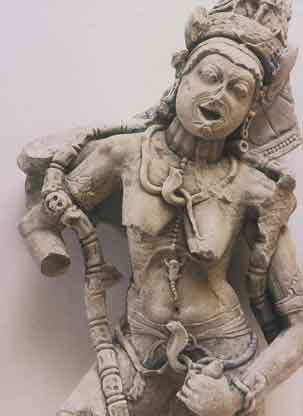 The Goddess Camunda, India Central Medieval.
The Goddess Camunda, India Central Medieval.
Pele, Hawaii’s goddess of volcanic fire, is a hag. Her skin is rough and black. She is a raging, destructive power. Camunda, an aspect of the Hindu goddess Kali, dances in the cremation ground, eating corpses. Her hunger can never be satisfied. In constant agony, she fills the world with her terrible cries.
These are lesbian images, kindred spirits to all Raging (Lesbian) Feminists, patron saints of S.C.U.M. – the Society for Cutting Up Men.[i] Anger and vengeance are powerful, creative forces in lesbian responses to women’s oppression.
Aspects of the gay and lesbian civil rights movement would have us forgo our fury. Dressed in suits and ties, acting like respectable people, we represent ourselves as innocent victims of unjust treatment. Our wounds are honored, but not our rage, hostility, and aggression. In contrast, the Queer movement of the 1990’s invoked the archetype of the Destroyer, vivifying lesbian and gay identity.
“I HATE STRAIGHTS,” the Queer Manifesto of 1990 reads. “They’ve taught us that good queers don’t get mad. They’ve taught us so well that we not only hide our anger from them, we hide it from each other. WE EVEN HIDE IT FROM OURSELVES. We hide it with substance abuse and suicide and overachieving in the hope of proving our worth. They bash us and stab us and shoot us and bomb us in ever-increasing numbers and still we freak out when angry queers carry banners or signs that say, BASH BACK . . . . LET YOURSELF BE ANGRY. Let yourself be angry that the price of visibility is the constant threat of violence, anti-queer violence to which practically every segment of this society contributes. Let yourself feel angry that THERE IS NO PLACE IN THE COUNTRY WHERE WE ARE SAFE, no place where we are not targeted for hatred and attack, the self-hatred, the suicide – of the closet.”[ii]
The Queer Manifesto catches “the pure rage that most of us had learned to swallow,” Frank Browning writes.[iii] We subdue our anger in the everyday acts of our lives – dropping our lover’s hand when we turn the corner, murmuring at pictures of babies we are not allowed to play with, marking all the weddings and anniversaries that celebrate heterosexual privilege, carefully choosing where and when we are open about our evenings, our households, our friends dying in mid-life.
The Queer Manifesto continues, “The next time some straight person comes down on you for being angry, tell them that until things change, you don’t need any more evidence that the world turns at your expense . . . . And tell them not to dismiss you by saying, ‘You have rights,’ ‘You have privileges,’ ‘You are overreacting,’ or ‘You have a victim’s mentality,’ Tell them, ‘GO AWAY FROM ME, until YOU can change.’ ”
Rage is energy that allows us to use queer identity as a profound interrogation of the straight world. If we are mad enough, we can see straight as every unexamined life that reeks of unexamined privilege. Straight is the preposterous designation of sexual difference and indifference that orders the meaning of everything, from apple pie to urban planning. We want to burn it down, shake it up, tear it to pieces. Like the Ancient Greek Furies, we are FURIOUS. We want justice, retribution, and torment for all who have offended us.
Time after time, lesbian and gay people relinquish their rage. We keep greeting homophobia with gentleness, acceptance and love. At what cost? If we always only forgo our anger, we give away our power. Queer rage is what puts deviance back in sight. Anger lets us acknowledge how our passions twist and redirect the meaning of things. Instead of hopelessly affirming that we are ordinary people, we can use homosexuality to rage against the suffocating weight of ordinariness.
Western culture represses consciousness of all the rage it generates; it has never honored the Destroyer. In Ancient Greece, the Olympian Gods banished the Furies – that fearful lesbian sisterhood with their taste for vengeance.[iv] Christianity would also resist or conquer the Destroyer, which is identified with the Devil and with Death. The dream of modern mental health likewise rejects destructive emotions: aggression, hostility, cruelty, anger, revenge, retaliation. These denied emotions return as the unacknowledged shadow, possessing personal and global relationships. Being queer means we can engage the archetype. By entering its mystery, we might assimilate its power, even while we loosen its grip.
[i] Valerie Solanas wrote and self-published the SCUM Manifesto in 1967. It was reprinted in 1996 by AK Press, San Francisco and Edinburgh.
[ii] quoted in Frank Browning, 1994.
[iii] ibid.
[iv] see Aeschylus (525-456 BC), The Eumenides.


